Sushi and Sashimi are dishes loved by many. However, not everyone fully understands the similarities and differences between these two delicacies, as well as the best way to savor them. Don’t worry, we’ll unravel all these details right in this article.
Sashimi and Sushi: Similarities and Differences Between Two Delicacies
Many people often confuse sushi and sashimi. They have similar-sounding names and use similar ingredients, but in reality, these two dishes have many differences.
Sushi is known as a dish that uses rice mixed with various ingredients such as vegetables, fish, and fresh seafood. Sushi comes in various types to cater to different tastes.
Sashimi, on the other hand, is a dish made from raw fish and is sliced into thin pieces, about 2.5 cm wide, 4 cm long, and approximately 0.4 cm thick. However, the size of each sashimi dish may vary depending on the type of fish and the chef’s preparation techniques.
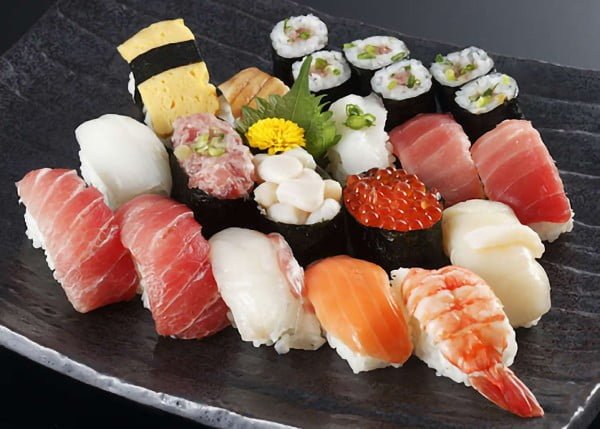
Similarities Between Sushi and Sashimi
In terms of culinary culture, both dishes are considered forms of art in terms of preparation and presentation in Japan.
Both dishes use fresh and meticulously prepared seafood as their main ingredient.
Differences Between Sushi and Sashimi
To understand the differences between these two dishes, we should focus on the ingredients, accompanying seasonings, and presentation.
|
Dish |
Sushi |
Sashimi |
| Main Ingredients | Sushi primarily consists of rice mixed with vinegar, combined with vegetables, fish, and fresh seafood. Sushi is categorized into many different types to satisfy various preferences. The rice used in sushi is typically white or brown rice that is cooked and mixed with vinegar. |
Sashimi is made from raw seafood such as tuna, squid, catfish, octopus, sea bream, and live shrimp. It is prepared with special cutting techniques. Sashimi is sliced into various sizes, depending on the ingredient and the chef’s preparation. |
| Accompaniments | Sushi is typically enjoyed with a variety of condiments such as wasabi, soy sauce, and pickled ginger. | Sashimi offers a wider range of accompaniments compared to sushi. It can be enjoyed with wasabi, soy sauce, ponzu sauce, and various herbs like shiso leaves and daikon radish, which are shredded into thin strips. |
| Preparation and Presentation | Sushi is divided into six basic types. Each type is made with different ingredients to create distinct flavors for diners. Sushi is often presented beautifully on a plate, with meticulous decoration.Sushi can be served as a main course because it contains all the necessary nutrients for diners. |
Sashimi is prepared by thinly slicing raw fish or seafood. The dish is elegantly presented with a harmonious arrangement of vegetables, seasonings, meat, and fish to appeal to different senses and tastes. |
In general, sushi and Sashimi are both renowned dishes from the land of the rising sun. However, sushi leans more towards aesthetic and artistic presentation.
On the other hand, Sashimi is considered an art of gustatory aesthetics. When savoring this dish, diners undoubtedly experience the delicate and impeccable flavors that leave an indelible impression.
Comparing Nutritional Values of Sushi and Sashimi
Nutritional Composition
- Sushi: Sushi tends to be richer in carbohydrates and fiber compared to sashimi. This is because sushi comprises white rice, seaweed, and raw vegetables, all contributing to its distinctive flavors and delightful crunch.
- Sashimi: In contrast, sashimi consists solely of raw fish or seafood, making it a superior source of protein and heart-healthy fats.
Specific Nutritional Comparison
Let’s delve into the table below to compare a 3.5-ounce (100-gram) portion of sushi and sashimi:
| Product Type | California Sushi Roll | Smoked Salmon Sashimi |
|---|---|---|
| Calories | 93 | 179 |
| Protein | 3 grams | 21.5 grams |
| Fats | 1 gram | 11 grams |
| Carbohydrates | 18.5 grams | 0 grams |
| Fiber | 1 gram | 0 grams |
The popular California sushi roll mentioned above typically includes cucumber, avocado, and crab or imitation crab. (References: 1, 2)
Note that most people typically consume more sushi per meal than sashimi, which can impact your overall nutritional intake.
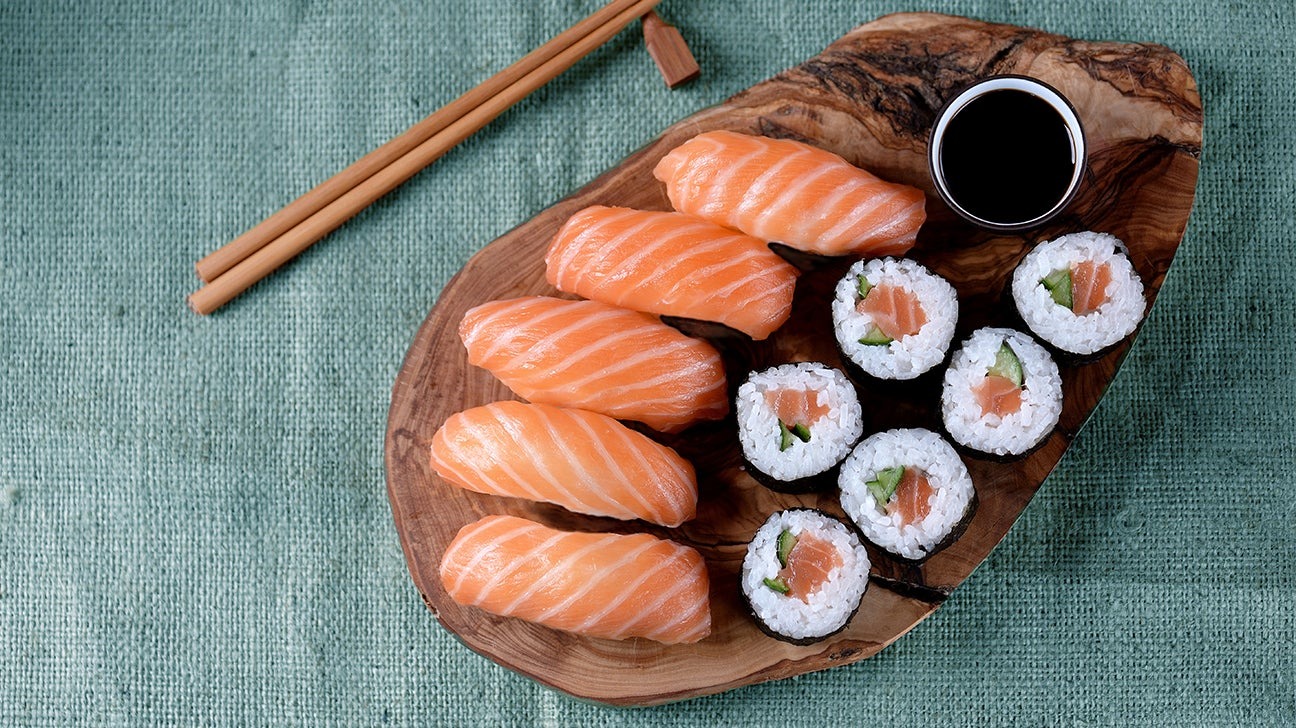
However, sashimi takes the lead in the protein department. This nutrient is crucial for repairing tissues, healing wounds, and muscle development. Research suggests that incorporating protein-rich foods like sashimi into your diet can help control hunger and reduce cravings. Furthermore, sashimi is a superior source of healthy fats such as omega-3 fatty acids, known to regulate inflammation and promote heart health. Sashimi isn’t just a delightful treat; it’s a boon for your health!
Shortcomings of Savoring Sushi and Sashimi
Sushi: Versatility and Vulnerabilities
Sushi is undeniably versatile, catering to a wider array of dietary preferences than sashimi. For instance, vegetarians or those averse to seafood can relish sushi rolls crafted with silky avocado or crisp cucumber. Isn’t that marvelous?
However, it’s worth noting that sushi also harbors refined carbohydrates and sodium, potentially triggering blood sugar spikes and raising blood pressure for some individuals (according to credible sources). Therefore, judiciously indulging in sushi is advisable, especially if you have health concerns.
Sashimi: Food Safety Concerns
Sashimi and many other sushi varieties encompass raw fish, fresh squid, or octopus, and this raises significant food safety concerns.
Consuming raw fish can heighten the risk of foodborne infections due to the potential presence of parasites and harmful bacteria if not meticulously prepared. Hence, selecting a reputable sashimi or sushi establishment should be paramount to ensure the well-being of yourself and those around you.
Many individuals are advised to abstain from consuming raw fish entirely, including pregnant women, children, and the elderly.
Fish and Heavy Metal Contamination
Fish is a high-quality food source, but certain fish species contain elevated levels of heavy metals like mercury, a toxic substance linked to various adverse health effects.
So, when savoring sushi and sashimi, always pay heed to the type of fish used and its origin. This is not only to safeguard your health but also to enhance your dining experience with peace of mind.
The Most Popular Sashimi Choices Nowadays?
Currently, sashimi is prepared with a wide variety of ingredients. Here are the most popular sashimi choices that many people prefer:
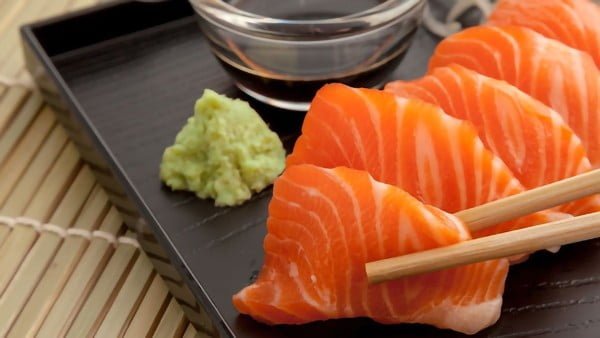
- Sashimi salmon: This is undoubtedly a dish that any sashimi enthusiast knows. The freshness and sweet taste of salmon, combined with skillful chef’s artistic decoration, meet the demands of discerning customers.
- Sashimi tuna: This is also one of the favorite sashimi choices for many people. Tuna is meticulously prepared, preserving its distinctive flavor that’s hard to mistake.
- Sashimi sea bream: Many people favorably call this the dish of autumn. Sea bream is rich in nutrients and offers a sweet, non-fishy taste. When enjoying this fish, it feels like it’s melting in your mouth.
- Sashimi sliced amberjack with egg: Amberjack with egg is seasoned with vinegar, giving it a rich, delicious taste. Not only that, this dish is beautifully presented, ensuring to impress even the most discerning customers.
- Sashimi red clam: If you’re unsure which sashimi to try for a delightful experience, go for red clam sashimi. Many people love this dish because it has a sweet and crispy texture. Enjoying it with soy sauce or wasabi will make it even more extraordinary.
- Salmon roe: This dish is visually appealing and favored by many when savoring sashimi. Salmon roe provides a wealth of essential nutrients and vitamins for the body.
- Sashimi kanpachi: Here’s another sashimi dish that many enthusiasts choose to indulge in. Kanpachi has a natural sweetness from the ocean. Catching this type of fish is not simple, making it a premium ingredient for sashimi.
How to Eat Sashimi the Right Way, as the Japanese Do?
In Japanese culinary culture, sashimi is considered an appetizer. When enjoying this dish, it awakens the senses of taste.
Sashimi is beautifully presented amidst various ingredients. Julienned daikon radish, a touch of pickled ginger, shiso leaves, wasabi, and soy sauce are arranged for everyone to enjoy.
However, not everyone knows how to eat sashimi in the Japanese style. Eating it incorrectly may lead to missing out on the delightful flavors of the dish.
The Japanese pay great attention to preparation and presentation for both aesthetics and sensory experience. This is considered an art form on the dining table. Moreover, even the smallest details of eating are meticulously observed.
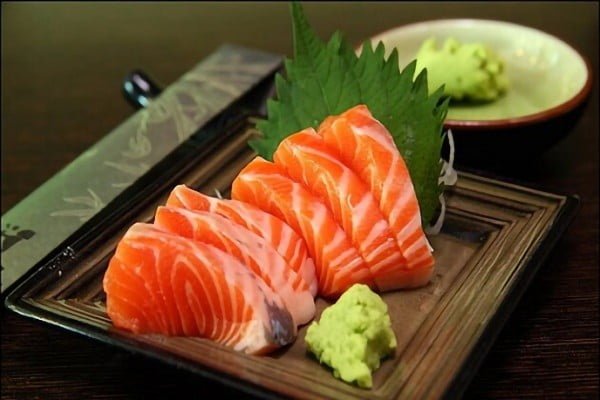
To savor sashimi in the authentic Japanese style, you can follow these guidelines:
- Step 1: Prepare your sashimi and add a little wasabi on top.
- Step 2: Gently dip the sashimi piece into the soy sauce. You should only dip a little, instead of drowning the whole piece, as it won’t affect the natural sweetness.
- Step 3: Place the sashimi in your mouth and savor it slowly. Chew slowly to fully appreciate the rich, sweet, and refreshing flavors.
You can also enjoy it with a bit of seaweed mixed with black sesame seeds. Remember to eat a few pieces of pickled ginger before moving on to other dishes. Pickled ginger cleanses your palate and refreshes your taste buds. Therefore, you’ll be able to fully appreciate the unique original flavors of each sashimi piece.
You shouldn’t consume sashimi with too many condiments or soy sauce, as it can disrupt the texture and flavor of the fresh seafood. Additionally, you should avoid biting small pieces of sashimi as this is considered disrespectful to the chef.
Criteria to Identify a Good and Authentic Sashimi Restaurant
Sashimi isn’t just a dish; it’s a cultural ambassador of Japanese cuisine. It’s not merely about food; it represents the finesse and soul of the Japanese people.
Today, sashimi is found in many different countries. In Vietnam, there are hundreds of thousands of different sashimi and sushi restaurants to cater to the diverse tastes of customers.
However, selecting a genuinely high-quality, authentic Japanese sashimi restaurant is no simple task. Consequently, many diners have found themselves disappointed with the sashimi they receive.
If you want to find a delicious, authentic Japanese sashimi spot, consider these criteria:
Top-Notch Fresh Ingredients
Sashimi is crafted from the core ingredients of fresh, raw meat or fish. These ingredients are captured, processed, and preserved meticulously and painstakingly. Therefore, if you want to know if a sashimi restaurant is good or not, first, pay attention to the ingredients.
The ingredients for sashimi must be fresh and properly stored. Only then can diners fully appreciate the natural sweetness and richness of the dish.
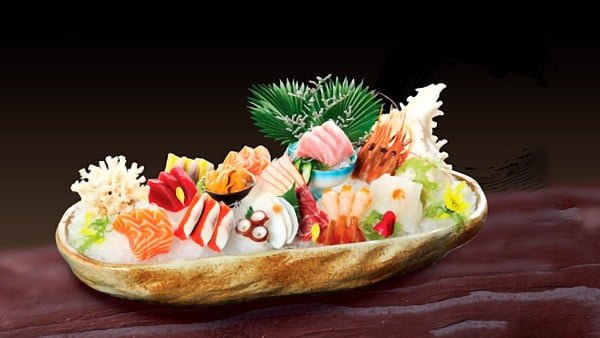
Authentic Accompaniments
The accompanying condiments for sashimi are also a key factor in making the dish genuinely Japanese. Typically, sashimi is enjoyed with soy sauce, wasabi, pickled ginger, shiso leaves, julienned daikon radish, and more. So when you dine, observe whether the restaurant provides all these accompaniments.
Reasonable Pricing
With these criteria in mind, you won’t need to worry about the cost of the service. Quality always comes with a price.
You should choose sashimi restaurants with clear, well-displayed pricing. The restaurant should offer services and menus at reasonable prices.
Reputable Sashimi Restaurants
This is the simplest way for you to choose a good sashimi restaurant. Establishments with a reputation or brand name usually guarantee excellent service and delicious dishes.
To find out which sashimi restaurant is reputable, you can seek the opinions of friends, family, or search online. You’re bound to discover a place that serves authentic and delicious sashimi.
Sashimi Havens You Need to Bookmark for a Visit
Currently, there are numerous restaurants and eateries specializing in sashimi across the country. If you’re a sashimi aficionado, save this list of delectable sashimi spots that we’re sharing below:
Top 3 Restaurants in Hanoi
If you live and work in Hanoi, consider visiting these top 3 restaurants:
Sushibar Hanoi
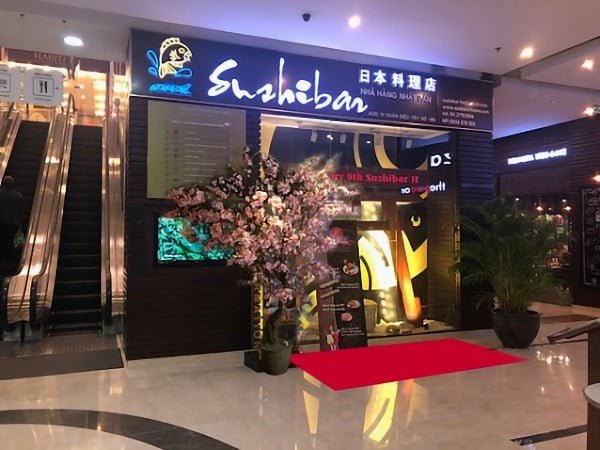
Sushibar Hanoi is the first restaurant we’d like to introduce to sashimi enthusiasts. Located on Trung Hoa Street in Cau Giay District, it’s incredibly easy to find.
As soon as you step inside this establishment, you’ll feel like you’ve wandered into a Tokyo eatery. The restaurant is adorned in a Japanese style, with cozy spaces to make everyone feel right at home. Sushibar Hanoi has gained quite a reputation among diners who seek to indulge in sashimi.
What truly satisfies customers when choosing a sushi bar as their Hanoi sushi restaurant is the freshness of the food. Each piece of fish and meat is expertly sliced to the perfect bite-size portion.
The sashimi is fresh and tender, and with every bite, you’ll experience the natural sweetness and creamy richness. Especially when enjoyed with the accompanying condiments, it elevates the dish to an unforgettable level of flavor.
The pricing at Sushibar Hanoi is affordable and suits a wide range of customers. In addition to delicious food, the quality of service here leaves diners incredibly satisfied.
- Phone:02437153894
- Fanpage: Sushibar Hanoi
- Opening Hours: 10 AM – 10 PM, seven days a week
- Google Map Rating: Google Reviews
- Address: 51 Đ. Xuân Diệu, Quảng An, Hoàn Kiếm, Hà Nội, Vietnam
- Menu: Menu
Kimono Restaurant
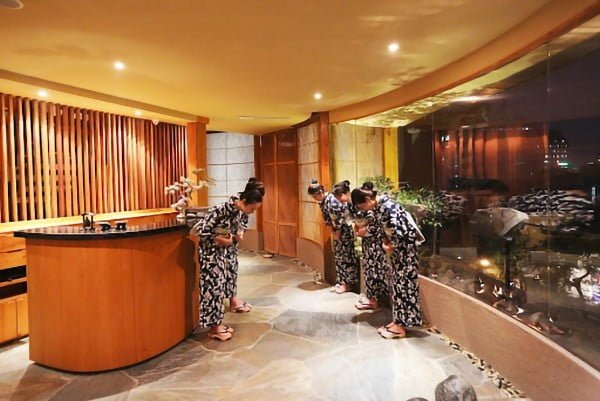
Here’s another suggestion for those who are unsure where to savor sashimi in Hanoi—Kimono Restaurant. The sashimi here is crafted from various types of seafood to meet the preferences of all customers.
Customers have highly rated the quality of food at Kimono. The dishes are prepared using fresh, imported ingredients without preservatives.
The restaurant offers a spacious and comfortable environment, with partitioned seating for a private dining experience.
- Phone:02439367629
- Fanpage:Japanese Cuisine (Kimono Restaurant)
- Opening Hours: 10 AM – 2 PM and 5 PM – 10 PM, seven days a week
- Google Map Rating: Google Reviews
- Address: 52-54 P. Lý Thường Kiệt, Trần Hưng Đạo, Hoàn Kiếm, Hà Nội, Vietnam
- Menu: Menu
Azuma Japanese Restaurant
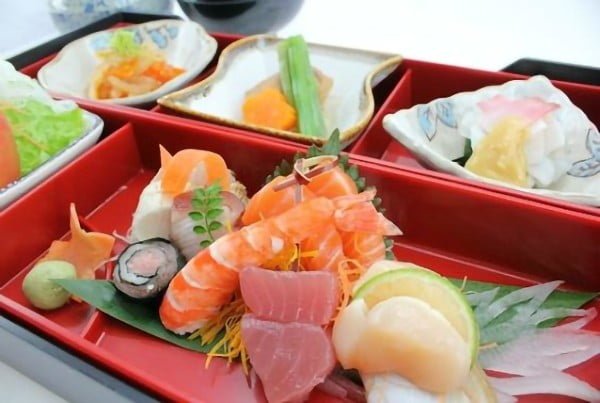
Azuma Japanese Restaurant is renowned among diners as one of the quintessential Japanese restaurants. It’s famed for its delicious, succulent sashimi.
But that’s not all; the restaurant boasts an extensive and diverse menu featuring hundreds of dishes from the Land of the Rising Sun. Here, you’ll have the opportunity to savor extraordinary delicacies. What’s more, there are enticing promotions that allow you to dine to your heart’s content without worrying about the price.
All the dishes are prepared using top-quality seafood imported from abroad, paired with tantalizing seasonings. Experienced chefs ensure that the food meets the exacting standards of Japanese cuisine.
- Phone:0936427524
- Fanpage: Azuma
- Google Rating: Google Map Review
- Operating Hours: 11 AM – 2 PM and 5:30 PM – 10 PM, seven days a week
- Address: 23 P. Ngọc Khánh, Giảng Võ, Ba Đình, Hà Nội, Vietnam
- Menu: Menu
List of 4 Restaurants in Saigon
Tony Sushi
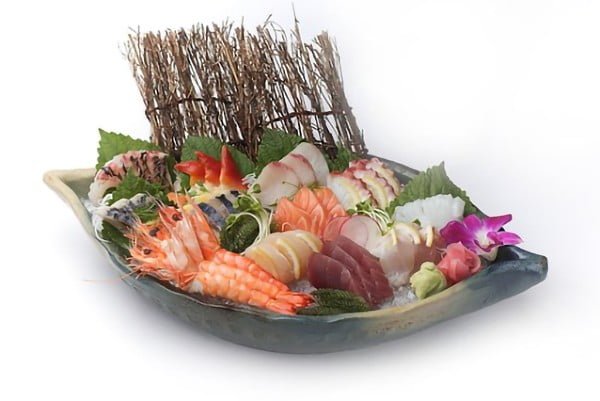
For those who have a fondness for sashimi, sushi in District 1, Tony Sushi is likely a familiar name. The restaurant places a strong emphasis on food quality, using only the freshest ingredients.
Here, the restaurant limits the use of sugar and other chemical seasonings. Sashimi is crafted from fresh ingredients, ensuring the purity of nature’s flavors.
The dishes at Tony Sushi not only prioritize quality but also presentation. Sashimi is beautifully adorned to provide diners with the most delightful experience.
Tony Sushi is highly regarded by customers for its elegant ambiance. Despite its simple design, it retains the natural beauty true to the Land of the Rising Sun, featuring predominantly earthy red-brown hues.
You can choose between regular seating or private rooms, making it a preferred venue for meetings, events, or romantic rendezvous.
Azuma Japanese Restaurant

Azuma Japanese Restaurant is celebrated among diners as a paragon of Japanese authenticity. Here, the star of the show is the exquisite and succulent sashimi.
But hold onto your chopsticks; their menu is a treasure trove of Japanese gastronomy, offering a kaleidoscope of dishes from the land of the rising sun. Dining here is an invitation to an exquisite culinary journey. And what’s more, there are tantalizing promotions that allow you to indulge without depleting your wallet.
Every dish is a masterpiece, concocted from top-tier seafood imported from overseas, adorned with captivating seasonings. The experienced chefs take pride in ensuring that every bite adheres to the exacting standards of Japanese cuisine.
- Phone:0936427524
- Fanpage: Azuma
- Google Rating: Google Map Review
- Operating Hours: 11 AM – 2 PM and 5:30 PM – 10 PM, seven days a week
- Address: 23 P. Ngọc Khánh, Giảng Võ, Ba Đình, Hà Nội, Vietnam
- Menu: Menu
List of 4 Restaurants in Saigon
Tony Sushi

For aficionados of sashimi, sushi in District 1, Tony Sushi needs no introduction. This eatery is obsessed with food quality, consistently sourcing the freshest ingredients.
Here, they shun sugar and synthetic seasonings, ensuring that sashimi is a pure, unadulterated celebration of nature’s flavors.
But it’s not just about taste; Tony Sushi places a premium on presentation. Each sashimi plate is a work of art, a feast for both the palate and the eyes.
What’s more, this restaurant earns high praise for its elegant ambiance. While the design is understated, it exudes the natural charm of the Land of the Rising Sun, with a color palette dominated by rich earthy tones of red and brown.
Here, you can opt for communal seating or the seclusion of private rooms, making it a favored venue for business meetings, special events, or romantic tête-à-têtes.
- Phone: 090 255 36 33
- Fanpage: Sushi Tony
- Operating Hours: 9 AM – 9 PM every day of the week
- Google Map Rating: Google Review
- Address: 219 Đ. Nguyễn Công Trứ, Phường Nguyễn Thái Bình, Quận 1, Thành phố Hồ Chí Minh, Vietnam
- Website: https://sushitony.vn
- Menu: Menu
Ikigai Sushi
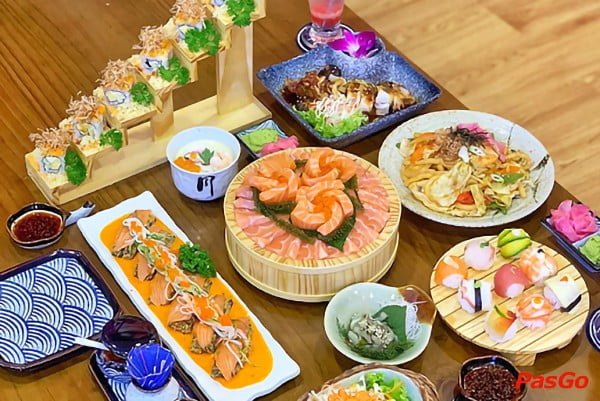
If you’re pondering where to relish delectable yet affordable sashimi and sushi in Saigon, look no further than Ikigai Sushi. This eatery is a marvel of Japanese-inspired architecture, complete with hanging lanterns.
The star attraction at Ikigai Sushi is undoubtedly the salmon sashimi. Each slice of salmon is meticulously prepared, cut into delicate, eye-catching patterns resembling adorable miniature flowers.
Beyond sashimi, you can embark on a culinary journey through their diverse menu, with each dish exuding an authentic Japanese essence.
- Phone: 0828828149
- Fanpage: Ikigai Sushi
- Google Rating: Google Map Review
- Operating Hours: 11 AM – 10 PM every day of the week
- Address: 236 Nguyễn Trọng Tuyển, Phường 8, Phú Nhuận, Thành phố Hồ Chí Minh 700000, Vietnam
- Menu: Menu
Sushi KEI
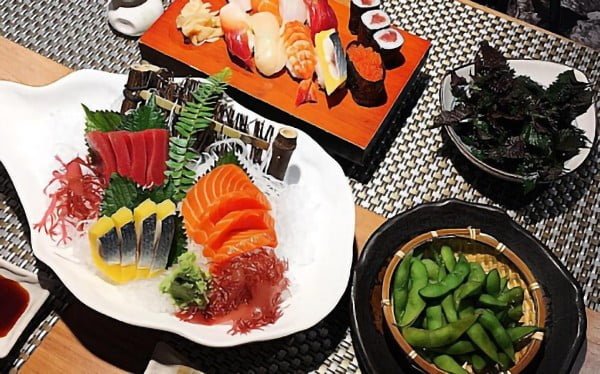
Introducing another haven for sushi and sashimi enthusiasts in Saigon – Sushi KEI. Currently, this brand boasts 8 branches scattered across the districts and suburbs of Ho Chi Minh City.
When you step into Sushi KEI, prepare to immerse yourself in the world of sashimi. The ingredients for these delectable creations are sourced fresh from the ocean. The restaurant places a premium on the purity of its dishes, opting for minimal seasoning to let customers savor the freshest flavors.
Sushi KEI offers an array of sashimi varieties, including salmon, tuna, and salmon roe. Each bite tantalizes your taste buds with the rich, velvety essence of the sea.
- Phone:18001277
- Fanpage: Sushi kei
- Operating Hours: 10 AM – 9 PM every day of the week
- Address: 11 Sư Vạn Hạnh, Phường 12, Quận 10, Ho Chi Minh City, Vietnam
- Menu: Menu
Grand Sushi KO
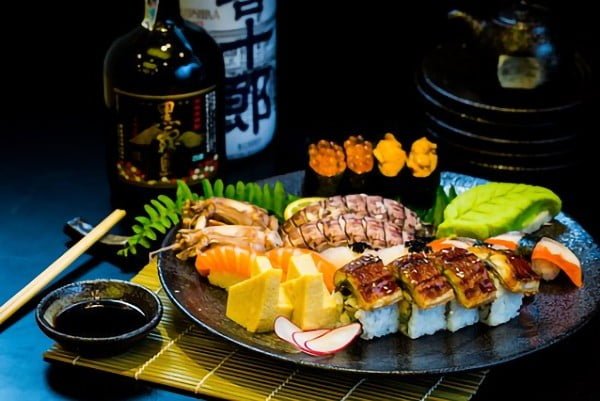
Grand Sushi KO combines modernity with an elegant touch, echoing the essence of Japan in its ambiance. This eatery is the top choice for many diners in Ho Chi Minh City seeking the perfect sashimi experience.
The sashimi here is incredibly fresh, preserving the natural sweetness of the ocean. You can enjoy it with a side of pickled ginger and finely sliced white radish.
When you dine at Grand Sushi KO, you not only savor exquisite cuisine but also benefit from various price promotions. Moreover, the restaurant’s staff provides attentive service, ensuring absolute customer satisfaction.
- Phone:0905300900
- Fanpage:Shinsekai Sushi
- Google Map Rating: Google Review
- Operating Hours: 11 AM – 10 PM every day of the week
- Address: SH 06, Park 5 Vinhomes Central Park, 208 Nguyễn Hữu Cảnh, Ward 22, Bình Thạnh District, Landmark 81, Ho Chi Minh City, Vietnam
- Menu: Menu
Three Restaurants in Da Nang
Fune Sushi & Sashimi
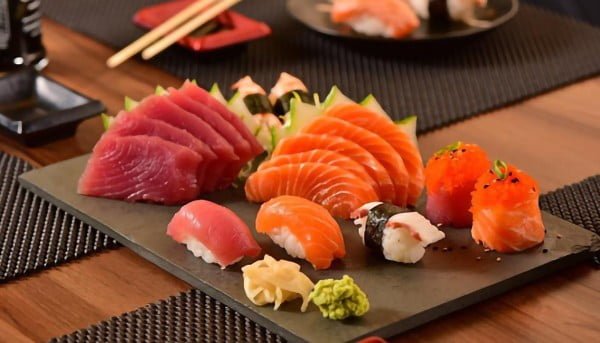
Finding a quality sashimi restaurant with affordable prices in Da Nang is the desire of many people today. If you happen to be in Da Nang for a trip and are unsure where to eat, be sure to visit Fune Sushi & Sashimi.
The dishes at Fune Sushi & Sashimi are highly appreciated by diners, especially sushi and sashimi. Each dish is meticulously prepared by the chefs, making them visually appealing.
- Phone:0947889468
- Fanpage: Fune Sushi
- Google Rating: Google Review
- Operating Hours: 11 AM – 2 AM every day of the week
- Address: 06 An Thượng 6, Bắc Mỹ An, Ngũ Hành Sơn, Da Nang 550000, Vietnam
Yes Sushi
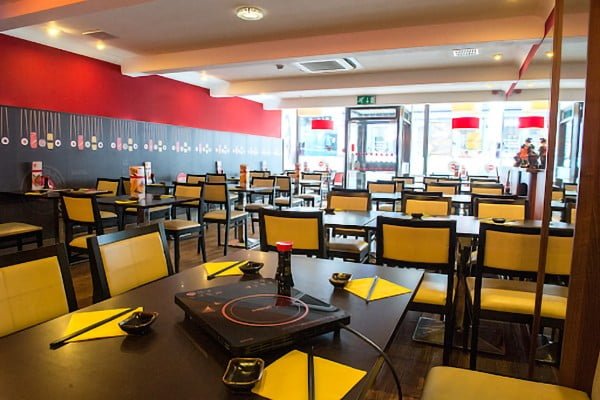
Yes Sushi is also one of the renowned sashimi restaurants in Da Nang that you should visit. The restaurant owner not only takes care of the food but also emphasizes the ambiance to provide the utmost comfort for all customers.
Yes Sushi boasts a team of professional chefs with years of experience in Japanese cuisine. Therefore, the restaurant is always confident in delivering delicious dishes with an authentic Japanese flavor to each of its customers.
- Phone:090 989 62 37
- Fanpage: Yes Sushi Da Nang
- Operating Hours: 10 AM – 2 PM and 4:30 PM – 10 PM every day of the week
- Address: 206 Châu Thị Vĩnh Tế, Bắc Mỹ An, Ngũ Hành Sơn, Da Nang 550000, Vietnam
- Menu: Menu
Akataiyo
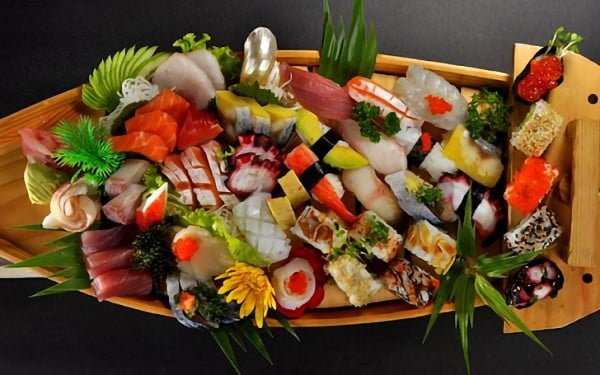
Akataiyo is the most preferred sushi and sashimi restaurant in Da Nang. With over 15 years of experience, the restaurant offers more than 250 dishes from the Land of the Rising Sun.
A small piece of sashimi holds the essence and flavors of Japan. Sashimi is made from fresh, imported ingredients, preserving its natural sweetness. So, if you have the chance to visit Da Nang, be sure to visit Akataiyo.
- Phone:0782521111
- Fanpage: Akataiyo
- Google Rating: Google Review
- Operating Hours: 10 AM – 2 PM and 5:30 PM – 10 PM every day of the week
- Address: 54 Nguyễn Du, Thạch Thang, Hải Châu, Da Nang 550000, Vietnam
- Menu: Menu
FAQs
What’s the difference between Sashimi and Sushi?
Sashimi is a dish made from thinly sliced raw fish, while Sushi uses mixed rice combined with vegetables, raw fish, and other seafood.
How should one properly enjoy Sashimi?
First, you should add a bit of wasabi to the Sashimi slice, then lightly dip it into soy sauce. When eating, chew slowly to fully appreciate the flavor.
What are the popular types of Sashimi?
Some popular types of Sashimi include Salmon Sashimi, Tuna Sashimi, Amberjack Sashimi, and Red Clam Sashimi.
Why is Sashimi considered an important part of Japanese culinary culture?
Sashimi is not just a dish but also reflects the sophistication and thoughtfulness of the Japanese in preparing and presenting food.
How can one identify a good and authentic Sashimi restaurant?
You should pay attention to the freshness of the ingredients, the authenticity of the accompanying seasonings, the appropriate pricing, and the reputation of the restaurant.
Hopefully, with the information provided here, you now have a better understanding of the similarities and differences between sushi and sashimi. If you have any further questions on this topic, don’t hesitate to contact toplist.com.co for the most persuasive answers.
Source: Here

